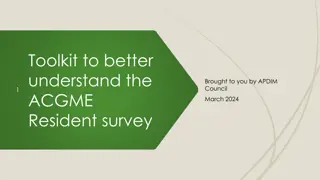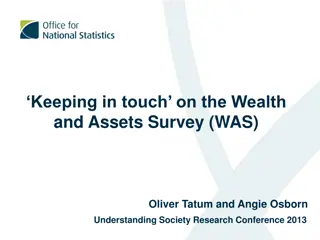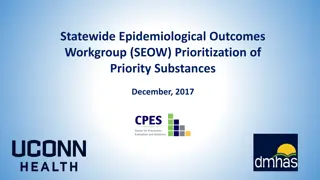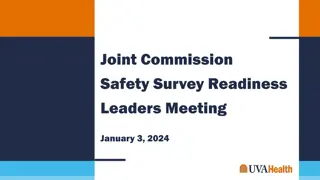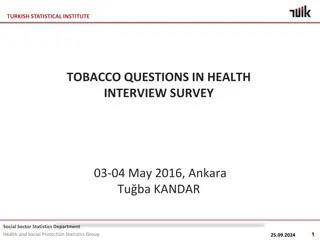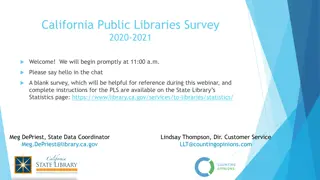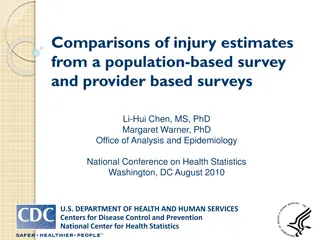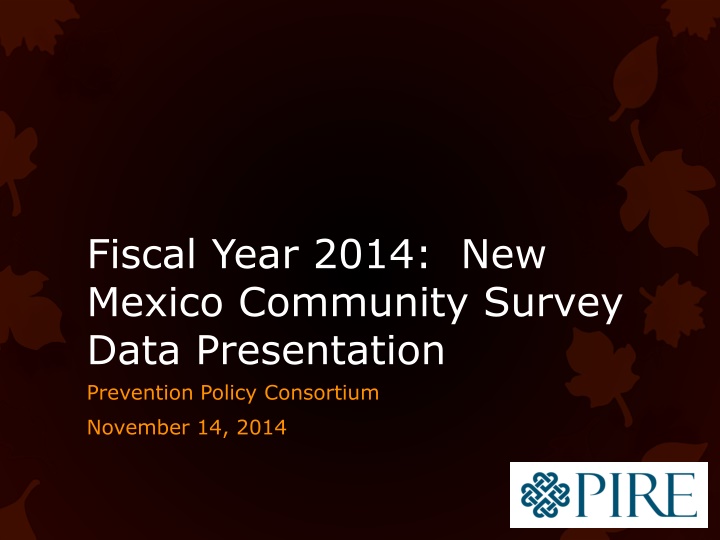
New Mexico Community Survey Data Presentation 2014
Explore the findings of the 2014 New Mexico Community Survey data presentation, covering prevention priorities, survey respondents, county demographics, and more. Gain insights into the state's efforts to address issues like underage drinking, DWI, prescription drug misuse, and mental health services.
Uploaded on | 3 Views
Download Presentation

Please find below an Image/Link to download the presentation.
The content on the website is provided AS IS for your information and personal use only. It may not be sold, licensed, or shared on other websites without obtaining consent from the author. If you encounter any issues during the download, it is possible that the publisher has removed the file from their server.
You are allowed to download the files provided on this website for personal or commercial use, subject to the condition that they are used lawfully. All files are the property of their respective owners.
The content on the website is provided AS IS for your information and personal use only. It may not be sold, licensed, or shared on other websites without obtaining consent from the author.
E N D
Presentation Transcript
Fiscal Year 2014: New Mexico Community Survey Data Presentation Prevention Policy Consortium November 14, 2014
New Mexico Statewide Prevention Priorities Underage Drinking Binge Drinking (all ages) DWI (all ages) Rx drug misuse (pain killers)
What is the New Mexico Community Survey? Developed to evaluate prevention progress in funded communities and across the state; It needed to be cost-effective and provide timely data on targeted outcomes and intervening variables Convenience sample of adults 18 and older; uses a time & venue- based sampling methodology to obtain a representative sample of community members (or at least comparable sample year to year) Includes 43 questions on: Alcohol use & DWI Social and retail access to alcohol for underage youth Perception of risk of legal consequences for breaking alcohol related laws Prescription drug use and abuse Access to prescription drugs Tobacco use Mental health and access to mental health services
Frequency of Survey Respondents by Survey Type 2014 NM Counties Represented Survey Type N % MVD Mail Out Invitation 354 5.2 32 MVD Website 166 2.4 12 PAPER- Convenience 5921 87.2 22 FACEBOOK (18-25 yr. olds) 352 5.2 24 Total 6793 100 33
County Frequency 432 307 130 237 255 17 11 381 147 340 15 6 269 180 4 9 161 314 18 18 36 493 15 424 348 415 480 212 271 374 150 18 267 Percent 6.4 4.55 1.92 3.51 3.78 0.25 0.16 5.64 2.18 5.03 0.22 0.09 3.98 2.67 0.06 0.13 2.38 4.65 0.27 0.27 0.53 7.3 0.22 6.28 5.15 6.14 7.11 3.14 4.01 5.54 2.22 0.27 3.95 BERNALILLO CATRON CHAVES CIBOLA COLFAX CURRY DE BACA DONA ANA EDDY GRANT GUADALUPE HARDING HIDALGO LEA LINCOLN LOS ALAMOS LUNA MCKINLEY MORA OTERO QUAY RIO ARRIBA ROOSEVELT SAN JUAN SAN MIGUEL SANDOVAL SANTA FE SIERRA SOCORRO TAOS TORRANCE UNION VALENCIA 2014 Valid Respondents by County
Demographics Describing the Sample
Demographics: Gender Unweighted Sample % Weighted Sample % NM Census % 70 60.4 60 50.9 50.4 49.6 49.1 50 39.6 Percent 40 30 20 10 0 Male (n=2625) Female (n=4012)
Demographics: Age Unweighted Sample % Weighted Sample % NM Census % 20 18 16 14 12 Percent 10 8 6 4 2 0 18-20 21-25 26-30 31-40 Age range 41-50 51-60 61-70 70+
Demographics: Race and Ethnicity Unweighted Sample % Weighted Sample % NM Census % 60 48.1 50 47.3 43.7 43.4 39.4 40 Percent 31.1 30 20 15.1 10.4 8.6 8.3 10 5.7 4.6 0 Non-Hispanic White Hispanic/Latino Native American Other
Demographics: Educational Attainment Unweighted: 18-25 yrs Unweighted: 26+ yrs Weighted: 18-25 yrs Weighted: 26+ yrs NM: 18-24 yrs NM: 25+ yrs 60 50 40 Percent 30 20 10 0 High School or less Some College College or more
Demographics: Other Unweighted Sample % Weighted Sample % 20 15 12.4 Percent 10 8.5 6.2 5.4 5 0 Military Service LGBT
ALCOHOL Outcomes Comparing Target and Comparison Community Estimates
Alcohol Consumption: Whole Sample Targeted Comparison 50% 40.4% 40% 36.7% 30% 19.3% 20% 17.2% 10% 4.5% 3.8% 3.2% 2.8% 2.7% 2.4% 0% Past 30-day alcohol use Past 30-day binge drinking Past 30-day drinking and driving Past 30-day binge drinking and driving Past year purchased alcohol for someone under 21
Alcohol Consumption: Males vs. Females Male Female Alcohol Use Indicator Target Comparison Target Comparison Past 30-day alcohol use 43.8 39.8 37.4 33.8* Past 30-day binge drinking 23.8 22.6 14.7 12.2* Past 30-day drinking & driving 5.0 4.9 3.9 2.6* Past 30-day binge drinking & driving 3.7 3.3 1.6 1.8 Past year purchased or provided alcohol for someone under 21 3.5 2.9 3.1 1.8* * p < .05
Alcohol Consumption: Race & Ethnicity Non-Hispanic White (n=2118) Native American (n=1023) Hispanic (n=3262) Other (n=390) Alcohol Use Indicator Target Compari- Target Compari- Target Compari- Target Compari- son son son son Past 30-day alcohol use 46.6 38.2*** 38.6 35.4 27.2 28.5 36.8 40.6 Past 30-day binge drinking Past 30-day drinking & driving Past 30-day binge drinking & driving Past year purchased or provided alcohol for someone under 21 14.7 14.6 22.9 20.8 19.0 19.4 18.3 19.4 3.8 2.9 4.6 4.4 6.7 6.2 4.8 7.6 1.7 1.6 3.3 3.4 4.0 4.2 2.8 7.3* 3.1 1.7* 3.1 2.6 4.7 3.7 3.7 7.1 *p < = .05, **p <= .01, ***p < .001
Alcohol Consumption: Age group Alcohol Use Indicator 18-20 21-25 26-30 31-40 41-50 51-60 61-70 70+ 18-25 Past 30-day alcohol use 40.0% 54.3% 46.9% 42.1% 39.6% 39.8% 32.5% 26.5% 45.8% Past 30-day binge drinking 23.9% 36.8% 29.5% 24.7% 19.6% 13.8% 6.4% 5.3% 32.1% Past 30-day drinking and driving 7.6% 8.3% 8.9% 6.0% 3.3% 3.1% 1.1% 0.2% 8.0% Past 30-day binge drinking and driving 6.0% 5.9% 6.3% 3.4% 1.8% 1.9% 0.2% 0.2% 5.9% Past year purchased alcohol for someone under 21 6.8% 11.5% 4.2% 2.4% 1.6% 1.5% 0.5% 0.9% 9.7%
Alcohol Outcomes: Comparing special subgroups with the whole sample Whole sample Military LGBT 60% 49.6% 50% 39.6% 39.1% 40% Percent 30.1% 30% 18.7% 20% 14.4% 10% 7.8% 6.0% 7.5% 4.3% 3.9% 2.7% 2.9% 2.5% 2.3% 0% Past 30-day alcohol use Past 30-day binge drinking Past 30-day drinking and driving Past 30-day binge drinking and driving Past year purchased alcohol for someone under 21
PAST 30-DAY ALCOHOL USE BY COUNTY* GRANT 56.2 SANTA FE 49.2 COLFAX 47.6 SAN MIGUEL 47.6 EDDY 44.0 TAOS 43.5 LUNA 43.3 RIO ARRIBA 41.1 TORRANCE 40.4 DONA ANA 40.0 SOCORRO 39.3 BERNALILLO 39.0 LEA 38.4 CHAVES 36.7 SANDOVAL 36.3 SAN JUAN 35.6 MCKINLEY 31.2 VALENCIA 29.6 HIDALGO 28.3 SIERRA 27.5 CIBOLA 25.8 CATRON 22.2 0.0 20.0 40.0 60.0 Percent
PAST 30-DAY BINGE DRINKING BY COUNTY COLFAX 31.6 EDDY 28.3 GRANT 28.1 SAN MIGUEL 27.1 CHAVES 23.9 BERNALILLO 23.4 LEA 23.4 RIO ARRIBA 22.4 DONA ANA 21.8 TAOS 21.4 MCKINLEY 21.3 HIDALGO 20.8 CIBOLA 18.2 TORRANCE 17.9 SAN JUAN 17.8 LUNA 17.7 SOCORRO 17.1 SANTA FE 17.1 SANDOVAL 17.0 VALENCIA 14.9 CATRON 10.5 SIERRA 9.6 0.0 10.0 20.0 Percent 30.0 40.0
PAST 30-DAY DRIVING AFTER TOO MUCH TO DRINK TAOS 9.1 CHAVES 7.8 CIBOLA 7.6 COLFAX 7.6 LEA 7.0 GRANT 6.8 HIDALGO 6.1 MCKINLEY 5.9 SOCORRO 5.5 DONA ANA 5.4 BERNALILLO 5.2 SANDOVAL 4.8 SAN MIGUEL 4.7 LUNA 4.4 VALENCIA 4.2 RIO ARRIBA 3.8 EDDY 3.6 SAN JUAN 3.4 SANTA FE 3.0 CATRON 3.0 SIERRA 2.0 TORRANCE 0.7 0.0 2.0 4.0 6.0 8.0 10.0 Percent
PAST 30-DAY DRIVING AFTER TOO 5+ DRINKS LEA 6.1 CIBOLA 5.3 TAOS 5.2 COLFAX 4.7 GRANT 4.7 CHAVES 4.6 DONA ANA 4.6 MCKINLEY 3.9 HIDALGO 3.7 CATRON 3.6 EDDY 3.6 VALENCIA 3.1 SAN MIGUEL 2.9 BERNALILLO 2.7 SANTA FE 2.6 RIO ARRIBA 2.5 SANDOVAL 2.5 SOCORRO 2.4 SAN JUAN 1.9 LUNA 1.9 SIERRA 1.0 TORRANCE 0.0 0.0 2.0 4.0 6.0 8.0 Percent
How underage youth (18-20) who reported drinking indicated they obtained alcohol (N=728) Took it from store without paying 0.6% Got it in Mexico 0.7% Bought it at a restaurant/bar/public place 1.3% Got it some other way 2.3% Bought it at a store 2.3% Took it from home 3.0% Parent/guardian gave or bought it 3.0% Someone underage gave or bought it 4.1% Adult family member gave or bought it 6.1% Got it at a party 10.0% Unrelated adult gave or bought it 15.3% 0.0% 2.0% 4.0% 6.0% 8.0%10.0%12.0%14.0%16.0%18.0% Percent
Alcohol Intervening Variables Very or somewhat difficult Target Access to alcohol Comparison Ease of access to alcohol by teens in the community* Ease of access to alcohol by teens from stores and restaurants** 12.2 14.7 57.1 61.5 Very or somewhat likely Target Perception of risk/legal consequences Comparison Likelihood of police breaking up parties where teens are drinking Likelihood of police arresting an adult for giving alcohol to someone under 21 *** 61.6 60.4 65.3 59.7 Likelihood of someone being arrested if caught selling alcohol to a drunk or intoxicated person*** 59.0 52.1 Likelihood of being stopped by police if driving after drinking too much*** Likelihood of being convicted if stopped and charged with DWI 74.1 66.9 84.5 83.6 *p < = .05, **p <= .01, ***p < .001
Prescription Pain Killer Outcomes Comparing Target and Comparison Community Estimates
Prescription Pain Killers: Whole Sample Target Comparison 100% 87.6% 77.5% 80% 56.4% 60% 56.0% 40% 30.0% 25.3% 20% 15.1% 11.6% 7.1% 5.8% 4.6% 4.7% 0% Great risk of harm using Rx pain killers for a non-medical reason*** Past year prevalence of receiving prescription painkiller** Past 30-day painkiller use to get high** Past 30-day prescription painkiller use** Given or shared prescription drugs with someone Medication locked or safely stored away
Prescription Pain Killers: Males vs. Females Male Female Prescription Drug Use Indicator Target Comparison Target Comparison Great risk of harm using Rx pain killers for a non-medical reason 76.7 86.1*** 78.6 89.6*** Past year prevalence of receiving prescription painkiller 25.8 26.8 24.8 31.5** Past 30-day painkiller use to get high 5.1 7.9* 4.1 6.0* Past 30-day prescription painkiller use 13.0 15.2 10.3 15.0** Given or shared prescription drugs with someone 4.8 5.6 4.3 6.2 Medication locked or safely stored away 55.4 52.0 56.7 59.2 *p < = .05, **p <= .01, ***p < .001
Prescription Pain Killers: Race & Ethnicity Non-Hispanic White Native American Hispanic Other Prescription drug use Indicator Target Compari- Target Compari- Target Compari- Target Compari- son son son son Great risk of harm using Rx pain killers for a non-medical reason Past year prevalence of receiving prescription painkiller Past 30-day painkiller use to get high Past 30-day prescription painkiller use Given or shared prescription drugs with someone 76.1 90.1*** 77.3 86.6*** 84.2 83.9 88.4 81.3 24.1 32.4*** 29.3 27.7 23.9 31.0 20.5 31.0 1.9 5.4*** 9.9 7.2 9.0 11.0 6.7 14.3 10.2 15.6** 14.9 14.2 14.1 16.1 7.6 16.9 3.3 5.9* 7.0 5.1 5.1 9.0 8.3 7.5 Medication locked or safely stored away 53.1 50.0 64.1 60.2 65.0 63.8 54.5 53.7 *p < = .05, **p <= .01, ***p < .001
Additional PRESCRIPTION DRUG Results
Prescription Pain Killer Use by Gender Whole sample Male Female 50% 40% 30.2% 29.0% 30% Percent 28.0% 20% 14.0% 14.6% 14.3% 10% 7.3% 6.6% 5.7% 0% Past 30-day prescription painkiller use Past 30-day painkiller use to get high Prevalence of receiving prescription painkiller past year
Prescription Pain Killer Use by Gender Whole sample Male Female 100% 87.4% 84.4% 85.7% 80% 58.7% Percent 56.3% 60% 53.0% 40% 20% 5.8% 5.6% 5.4% 0% Great risk of harm using Rx pain killers for a non-medical reason Given/shared prescription drugs with someone past year Medication locked or safely stored away
Prescription Pain Killer Outcomes by Race/Ethnicity Non-Hispanic White Hispanic Native American Other 50% 40% 29.4% 30.1% 29.3% 30% Percent 27.8% 20% 14.1% 15.8% 15.7% 14.2% 12.9% 10.5% 10% 7.4% 4.5% 0% Past 30-day prescription painkiller use Past 30-day painkiller use to get high Prevalence of receiving prescription painkiller past year
Percent Rx Pain Killer Use by Age Group Great risk of harm using Rx pain killers for a non-medical reason Prevalence of receiving prescription painkiller Past 30-day painkiller use to get high Past 30-day prescription painkiller use Given/shared prescription drugs with someone Medication locked or safely stored away Ages 18-20 21-25 26-30 31-40 41-50 51-60 61-70 70+ 75.8 80.6 81.3 83.0 83.8 89.5 92.5 90.8 26.8 22.9 23.4 27.5 25.2 34.7 32.9 33.2 12.2 7.2 8.8 8.4 5.6 5.1 5.5 4.0 17.7 13.1 14.4 15.1 10.1 15.6 17.0 13.1 11.1 7.8 6.1 7.4 5.5 5.1 2.9 2.0 52.1 61.5 57.7 57.7 53.7 54.9 57.7 55.4
Rx Pain Killer Use: Subgroup comparisons Whole Sample Military LGBT Rx Pain Killer Items Past 30-day prescription painkiller use 14.3 17.4 18.5 Past 30-day painkiller use to get high 6.6 8.2 15.1 Prevalence of receiving prescription painkiller past year 29.0 36.4 30.6 Great risk of harm using Rx pain killers for a non-medical reason 85.7 85.4 82.8 Given/shared prescription drugs with someone past year 5.6 5.0 10.8 Medication locked or safely stored away 56.3 53.5 53.2
Reasons for Prescription Drug Use 1.2% Cope with social pressure 1.3% Avoid the bad feelings of withdrawal 1.5% Affect the impact of other drugs 2.1% Substitute for other drugs or medications 3.4% Have fun with friends socially 3.5% Another reason 3.7% Get high, messed up or stoned 5.7% Cope with anxiety or stress 7.8% Help me sleep 14.3% For pain not identified by doctors 67.6% Treat pain identified by doctors/dentists 0.0% 10.0% 20.0% 30.0% 40.0% 50.0% 60.0% 70.0% 80.0%
Sources of Prescription Drug Use Bought on the internet 0.2% Bought in Mexico 0.7% Taken from a friend/relative 1.0% Other places 1.5% Bought from a dealer/stranger 1.7% Family member shared 6.3% Friend shared 7.4% A doctor/doctors prescribed 74.2% 0.0% 10.0%20.0%30.0%40.0%50.0%60.0%70.0%80.0%
Percent of sample reporting mental health concerns Whole sample Male Female 20.0% 16.1% 15.7% 15.3% 16.0% 11.7% 12.0% 11.1% 10.2% 8.0% 5.8% 5.4% 4.8% 4.6% 4.1% 3.5% 4.0% 0.0% Presence of a serious mental illness Having mental health or drug/alcohol problems in the past year Suicidal thoughts in the past year Received professional help on mental health or drug/alcohol problems in the past year
Mental Health Outcomes by Race/Ethnicity Non-Hispanic White Hispanic Native American Other 20.0% 18.2% 17.5% 17.0% 16.0% 14.4% 12.9% 11.3% 12.0% 10.1% 8.5% 8.5% 8.5% 7.0% 8.0% 6.2% 5.9% 4.2% 3.8% 3.6% 4.0% 0.0% Presence of a serious mental illness Having mental health, drug or alcohol problems in the past year Suicidal thoughts in the past year Received professional help on mental health, drug or alcohol problems in the past year
Mental Health Outcomes by Age Received professional help on mental health, drug or alcohol problems in the past year Having mental health, drug or alcohol problems in the past year Suicidal thoughts in the past year Presence of serious mental illness Age group 18-20 11.0% 21.2% 10.7% 12.3% 21-25 9.1% 23.3% 6.9% 12.7% 26-30 6.8% 18.1% 6.3% 13.1% 31-40 6.1% 18.3% 4.4% 13.2% 41-50 4.7% 13.0% 2.7% 10.1% 51-60 4.1% 17.1% 3.9% 13.5% 61-70 3.0% 11.9% 2.7% 9.4% 70+ 2.5% 6.4% 0.5% 4.1%
Mental Health Outcomes: Comparing special subgroups with the whole sample Whole Sample Military LGBT 35 32.3 30 25 20.0 Percent 20 15.7 14.6 13.9 13.3 15 11.1 11.1 10 5.4 4.3 4.1 4.1 5 0 Presence of a serious mental illness Having mental health, drug or alcohol problems in the past year Suicidal thoughts in the past year Received professional help on mental health, drug or alcohol problems in the past year
Where respondents sought mental health services Inpatient behavioral health services or detox 2.3% While in jail or prison 2.8% Other health practitioner 4.2% Emergency room 5.0% Peer specialist or recovery coach 5.5% Spiritual healer 5.7% Other healers like herbalist etc. 8.3% Faith-based services 11.2% Psychiatrist 13.5% Community mental or behavioral health center 16.7% Primary care provider 32.3% Private therapist or counselor 36.8% 0.0% 5.0% 10.0% 15.0% 20.0% 25.0% 30.0% 35.0% 40.0%
Types of mental health services received Inpatient (overnight) 2.8% Detox 3.6% Emergency care 4.3% Something else 6.3% Spiritual guide/healer 10.4% Self-help groups like 12- step, AA 10.5% Group therapy 10.8% Herbs, acupuncture or homeopathy 10.9% Medication 22.7% One on one therapy 46.0% 0.0% 10.0% 20.0% 30.0% 40.0% 50.0%
Tobacco Outcomes by Gender Whole sample Male Female 30% 28.2% 24.7% 25% 20.8% 20% Percent 15% 11.6% 10% 6.8% 5% 2.8% 2.7% 2.5% 2.1% 0% Any current cigarette use Any current chewing tobacco use Past year purchased tobacco for someone under 18
Tobacco Use by Race/Ethnicity Non-Hispanic White Hispanic Native American Other 30 25.38 25.31 24.61 24.48 25 20 Percent 15 10.0 10 6.93 6.75 6.52 4.82 5 4.2 3.02 2.0 0 Any current cigarette use Any current chewing tobacco use Past year purchased tobacco for someone under 18
Tobacco Outcomes by Age Group Any current chewing tobacco use Past year purchased tobacco for someone under 18 Any current cigarette use Age 18-20 21-25 26-30 31-40 41-50 51-60 61-70 70+ 31.4% 31.3% 36.5% 31.0% 25.2% 23.8% 16.8% 9.4% 11.1% 8.9% 10.6% 8.0% 8.6% 5.4% 3.8% 2.3% 13.6% 6.1% 4.1% 2.6% 1.5% 1.3% 0.5% 0.5%
Tobacco Outcomes: Subgroup Estimates Whole sample Military LGBT 50.0% 39.9% 40.0% Percent 30.0% 24.7% 23.3% 20.0% 10.1% 10.0% 8.7% 6.8% 6.5% 2.7% 1.6% 0.0% Any current cigarette use Any current chewing tobacco use Past year purchased tobacco for someone under 18







